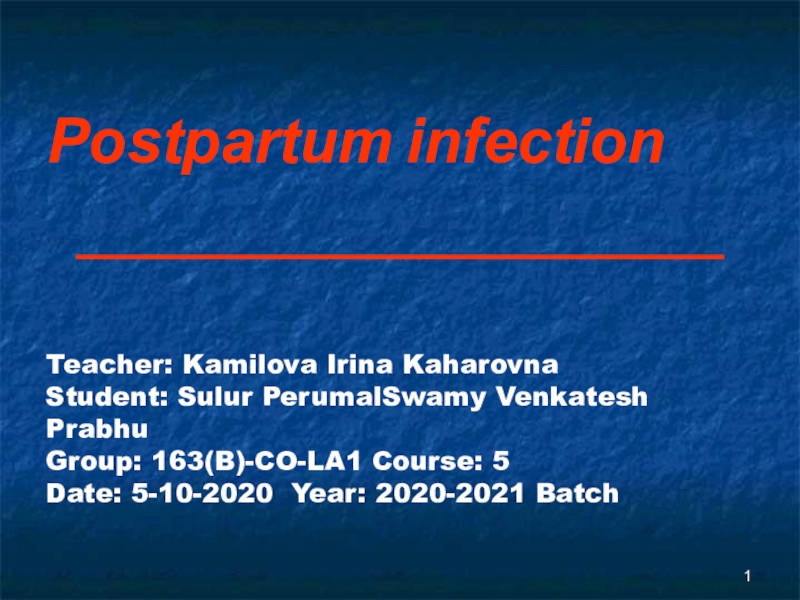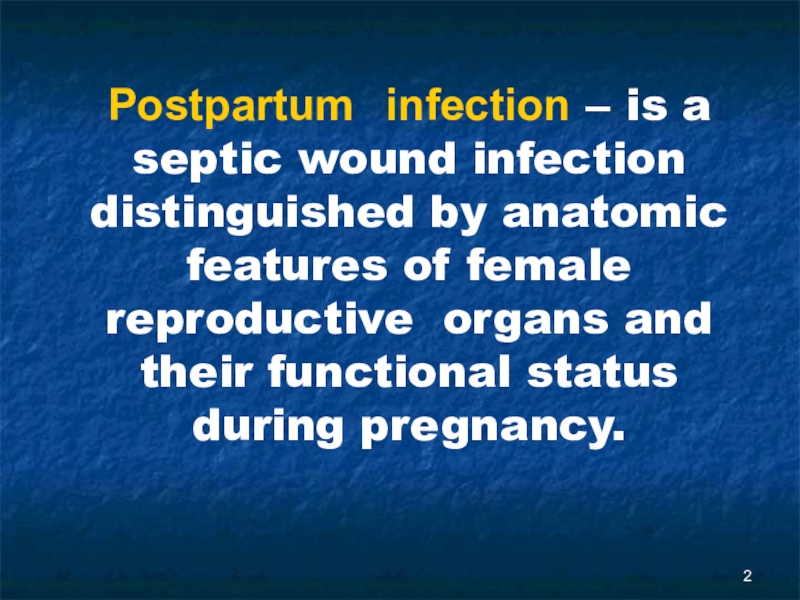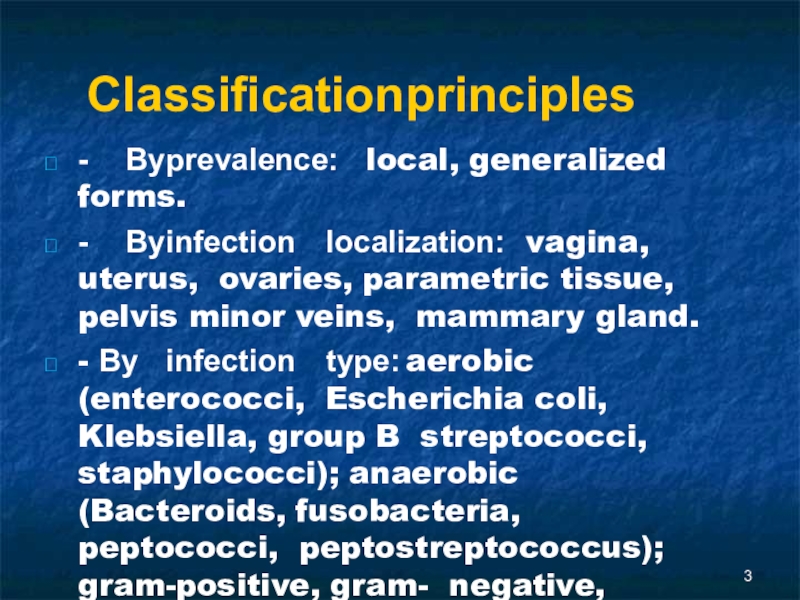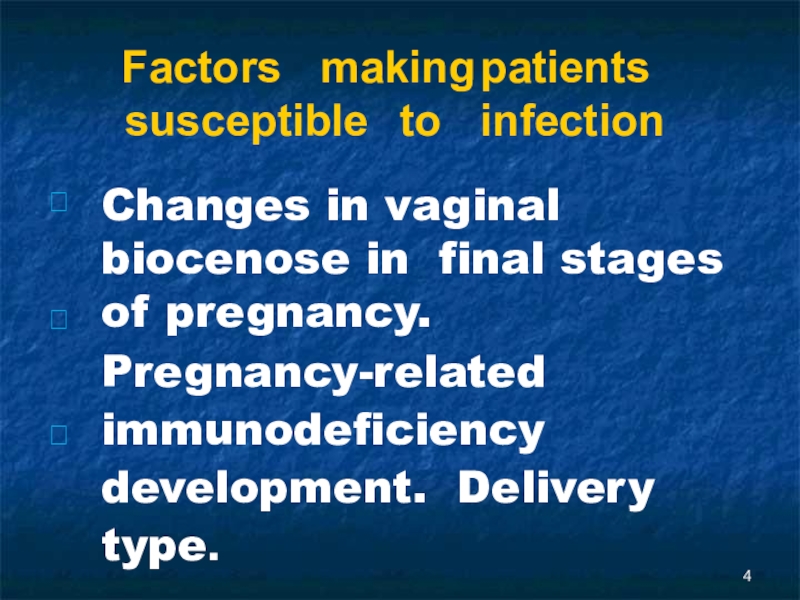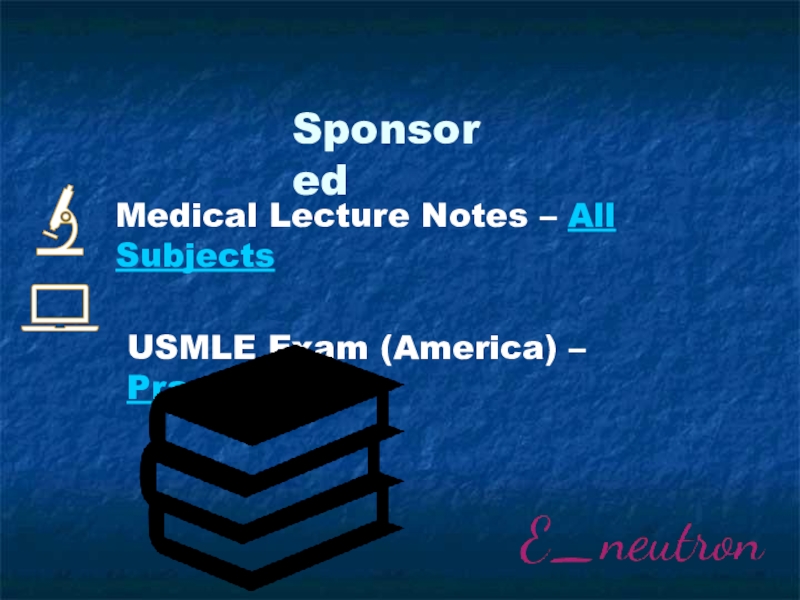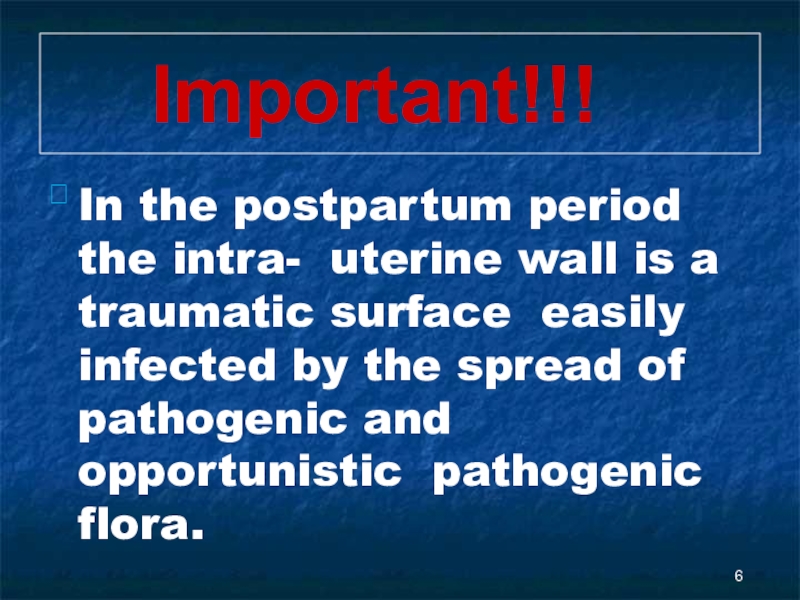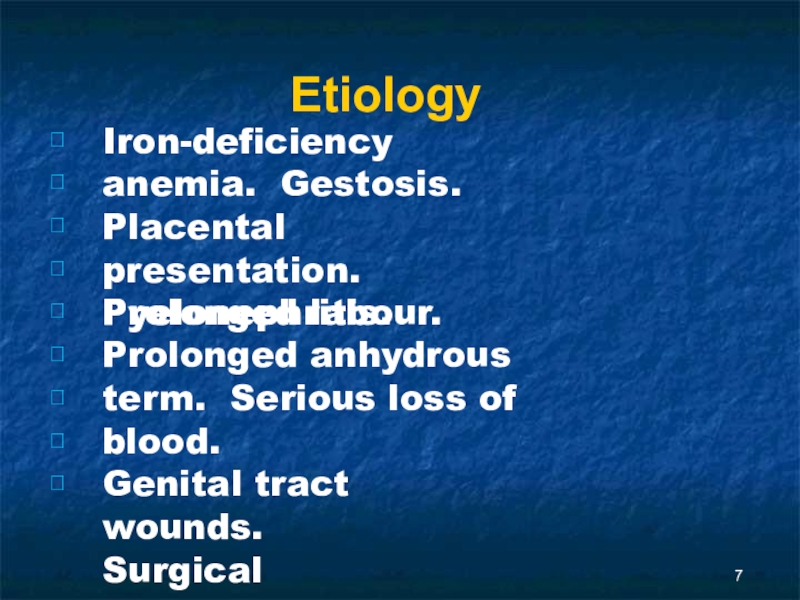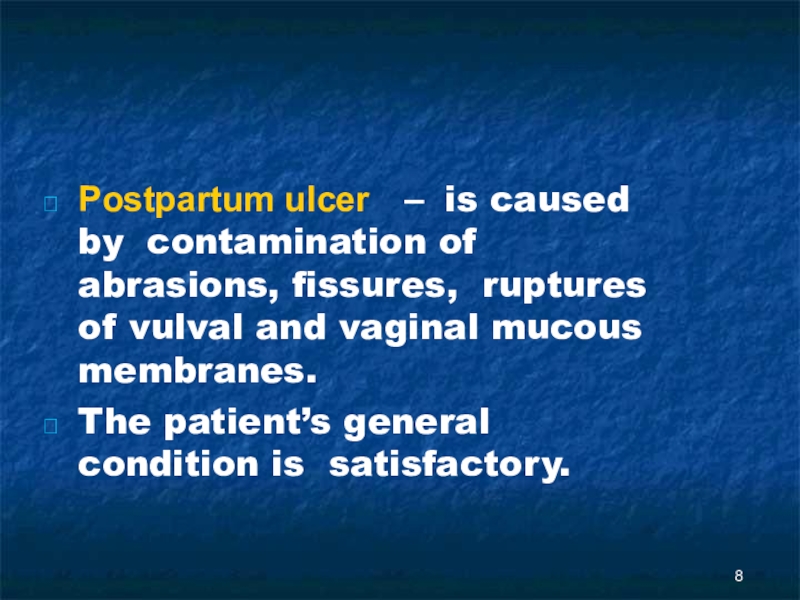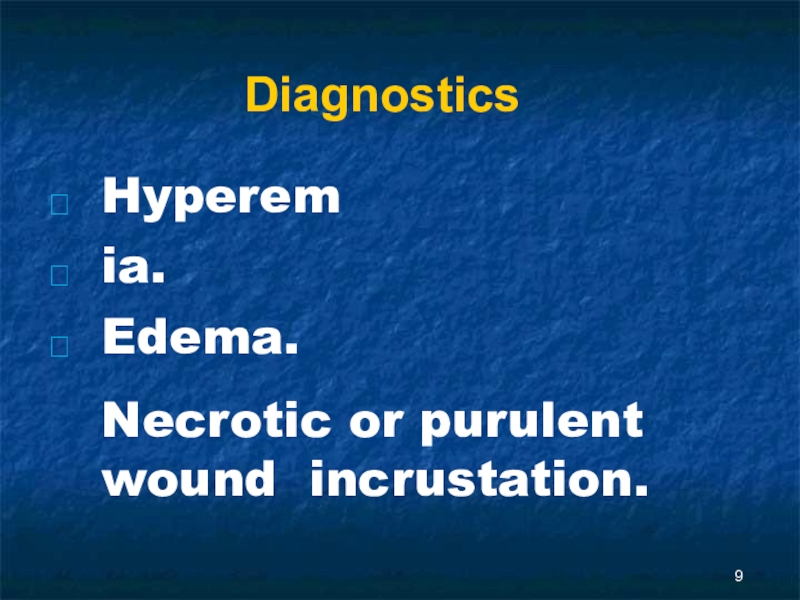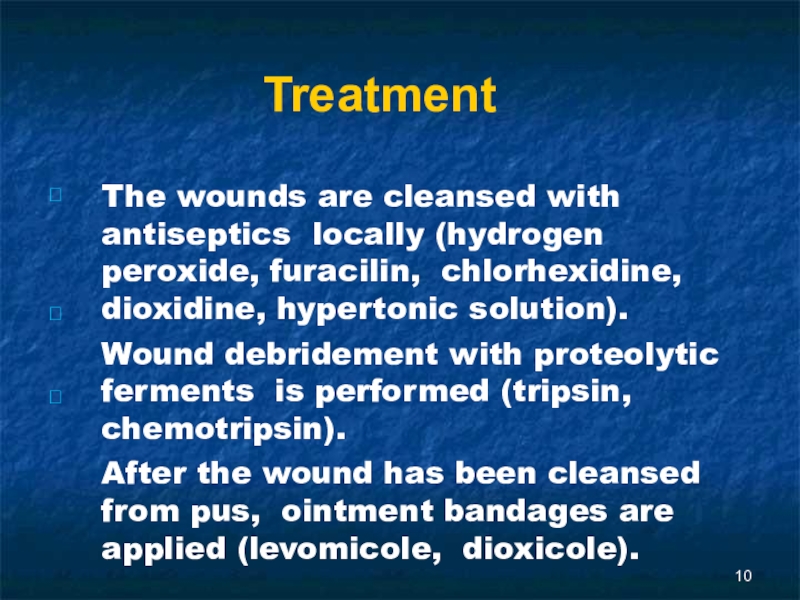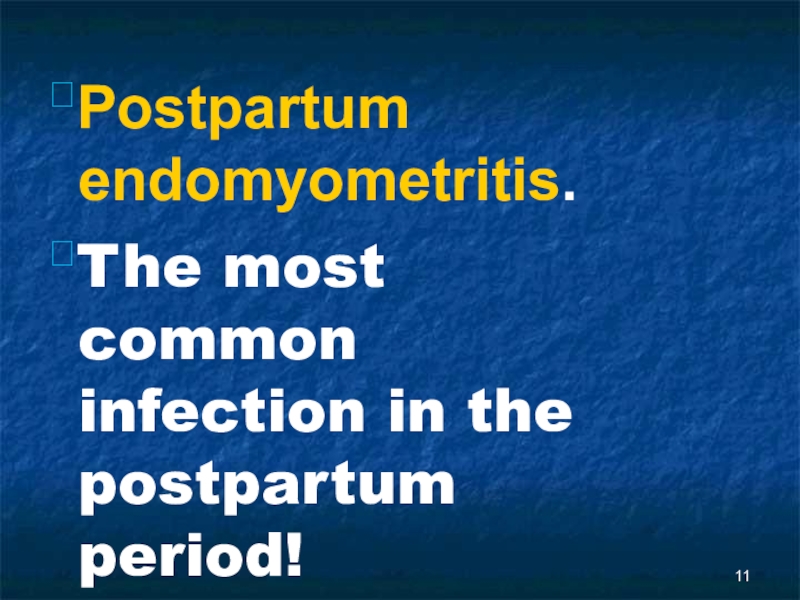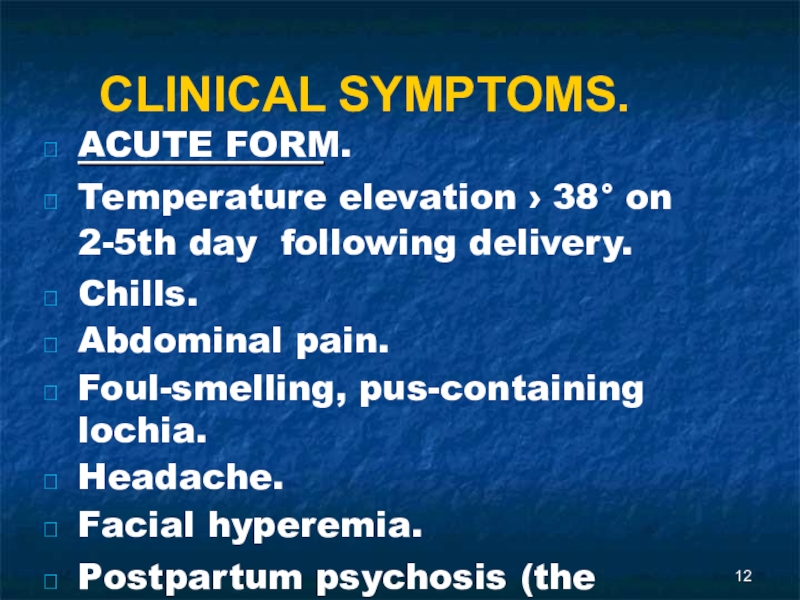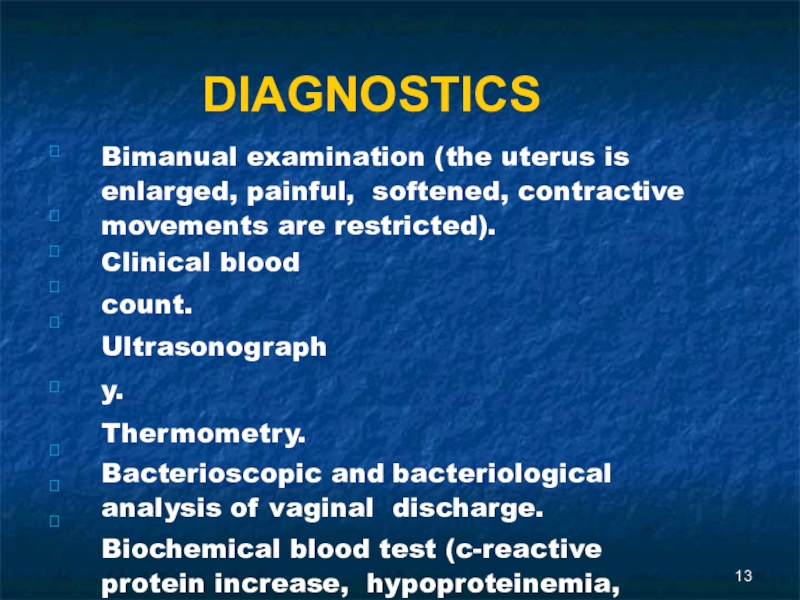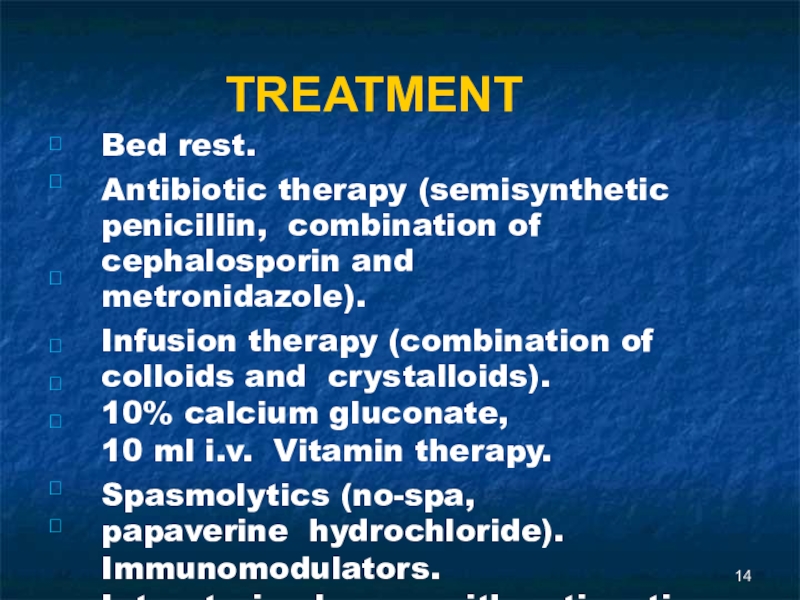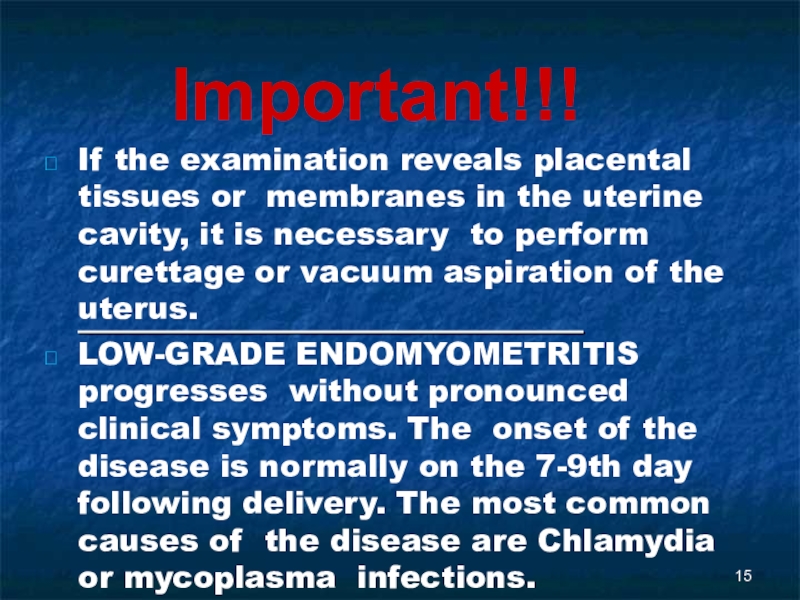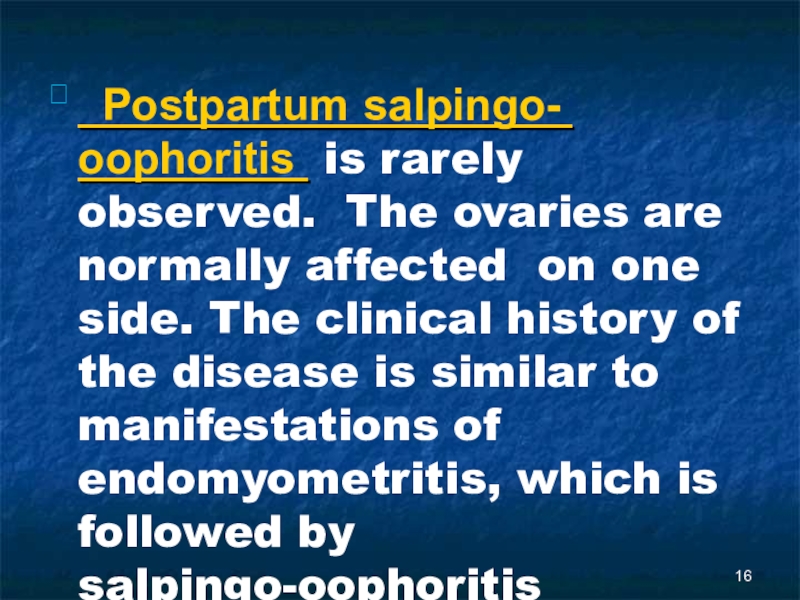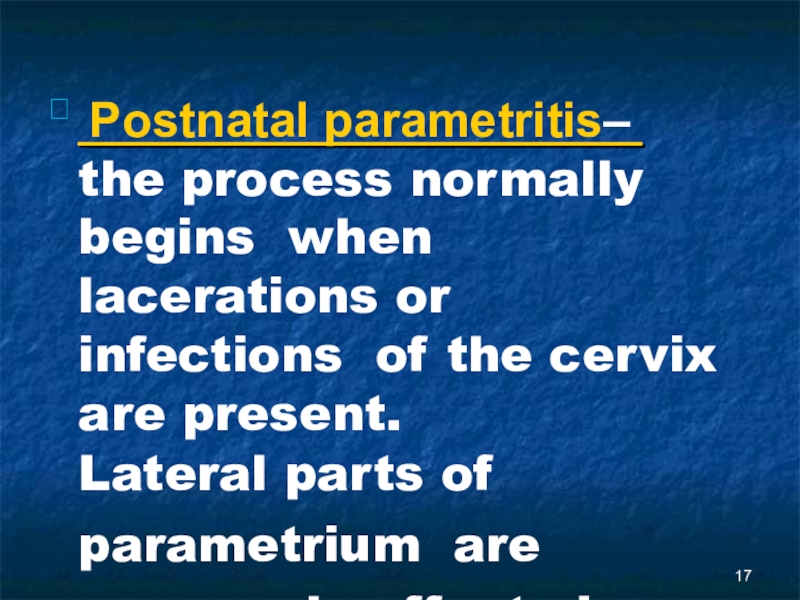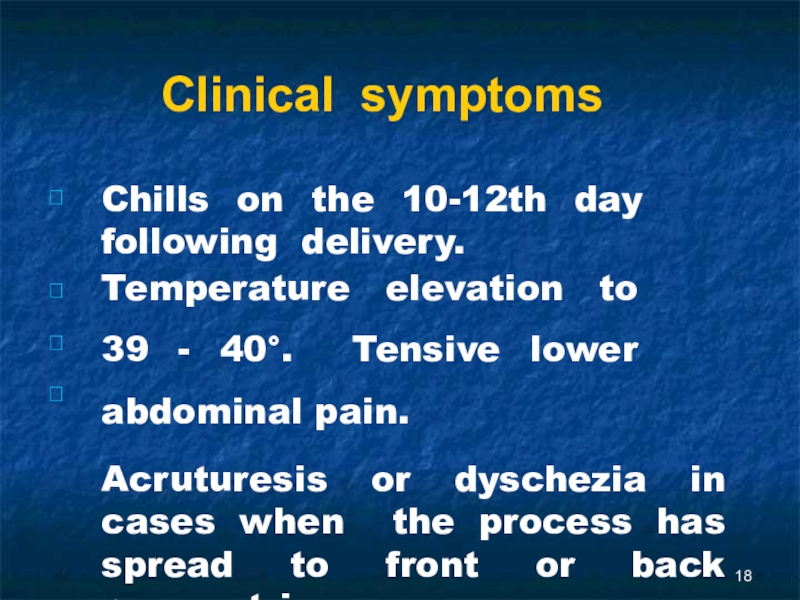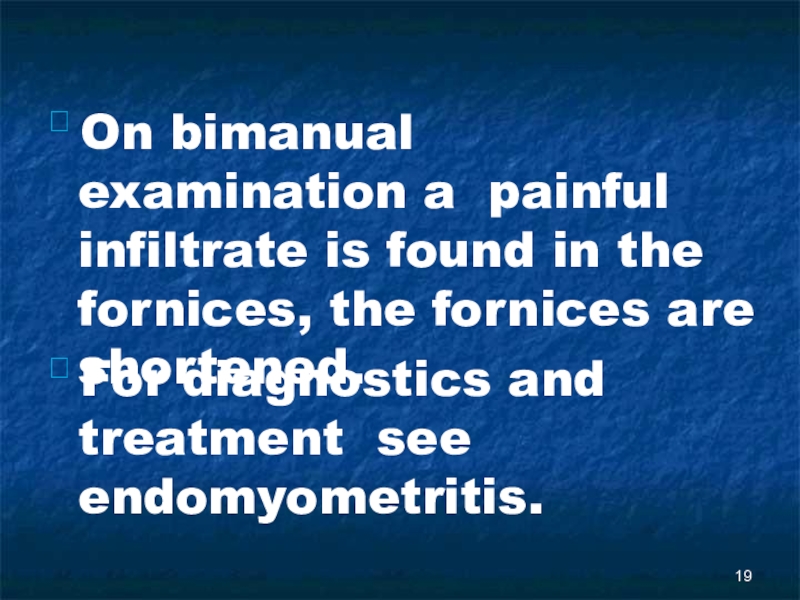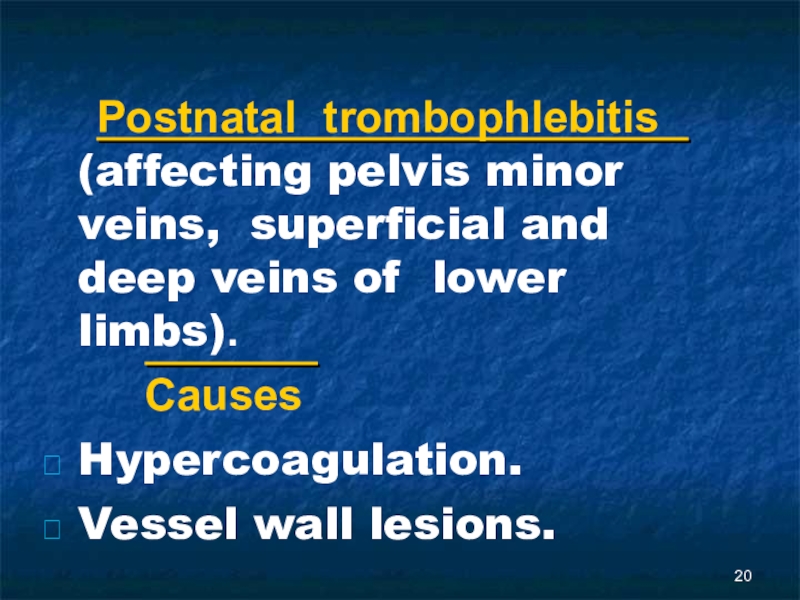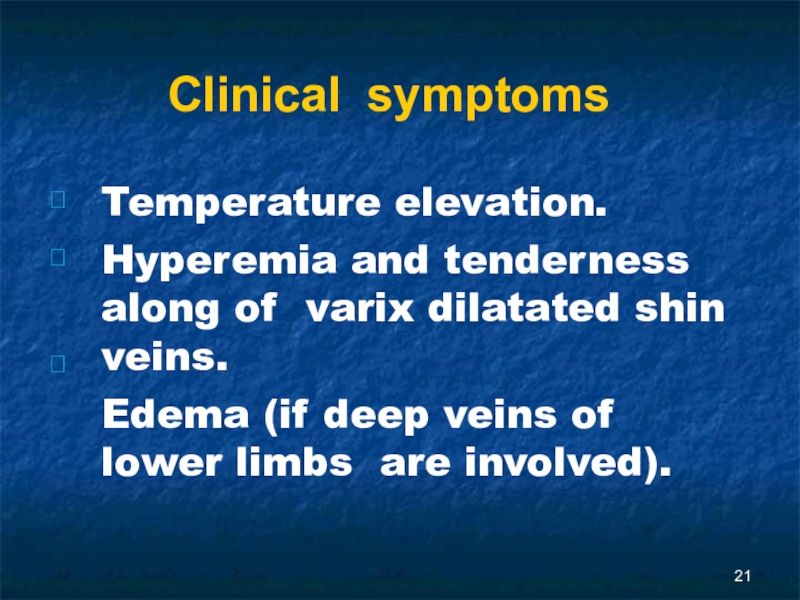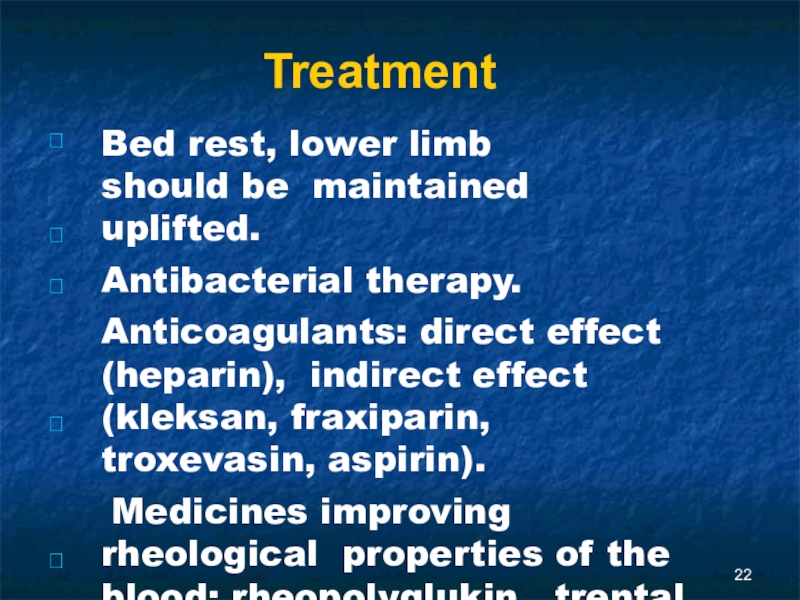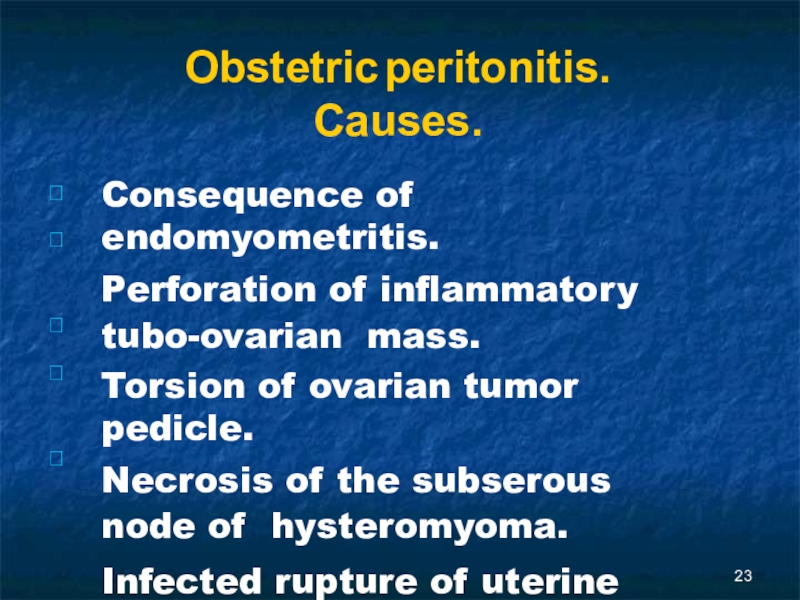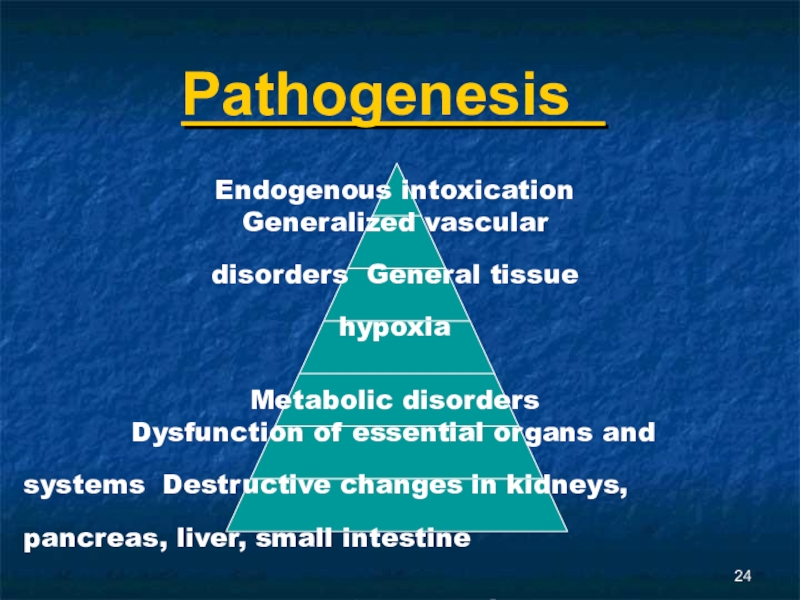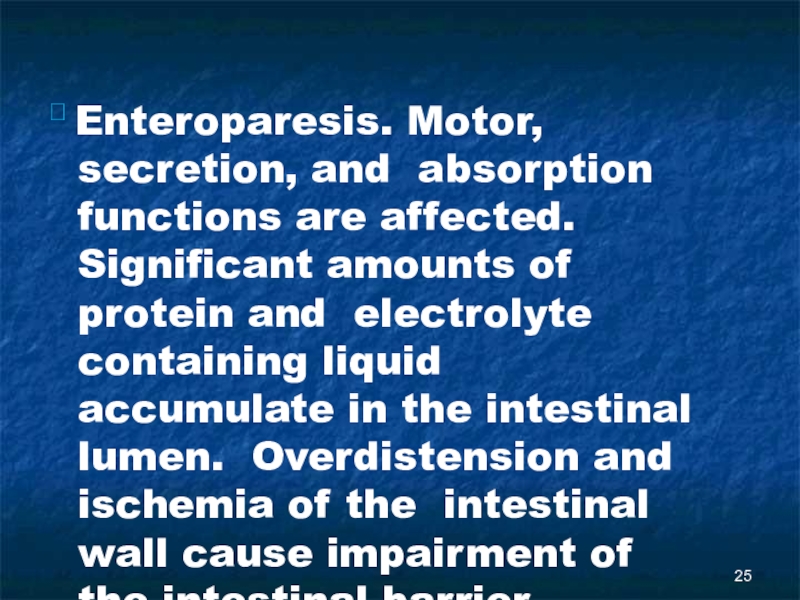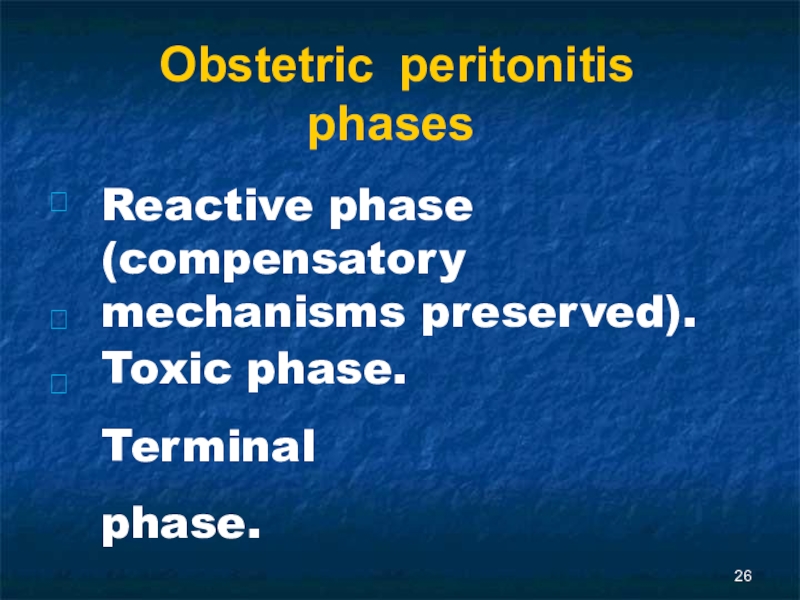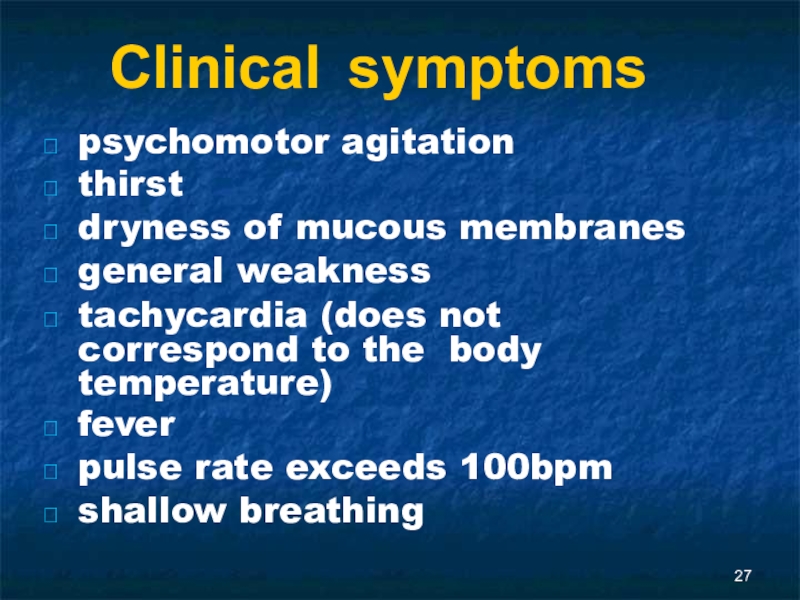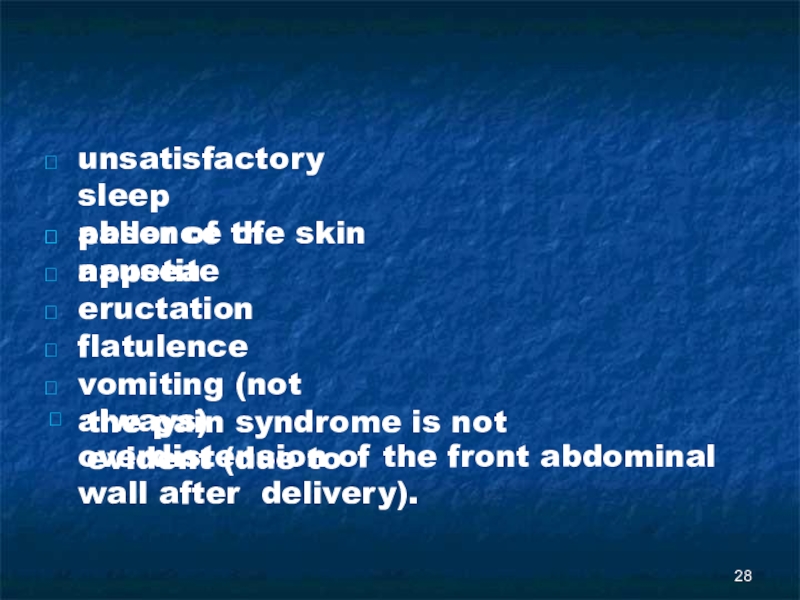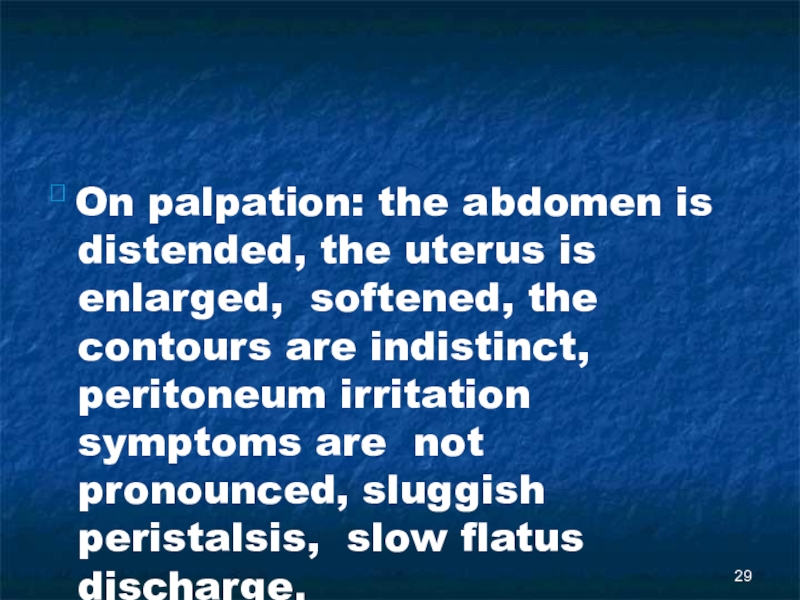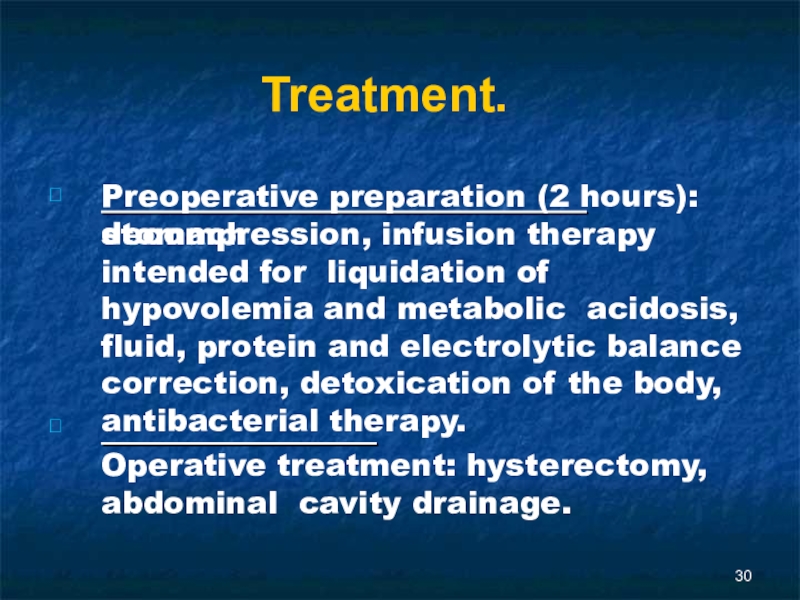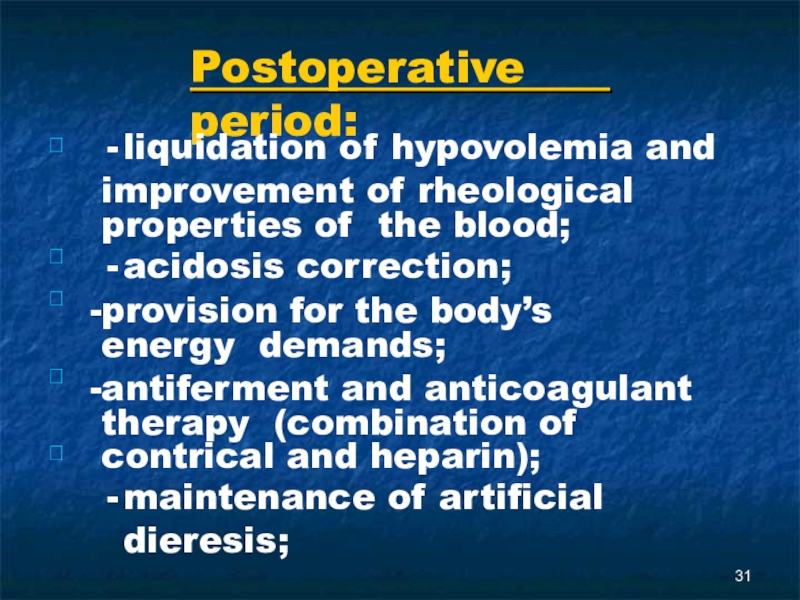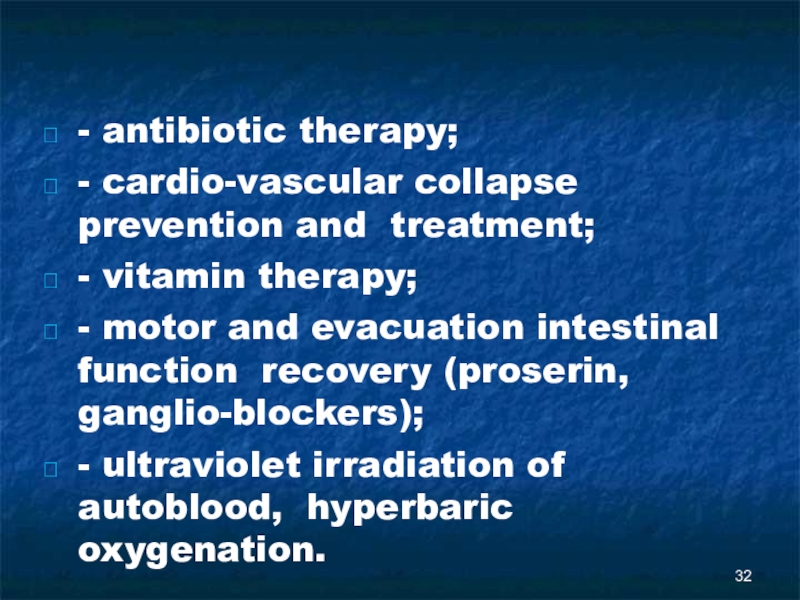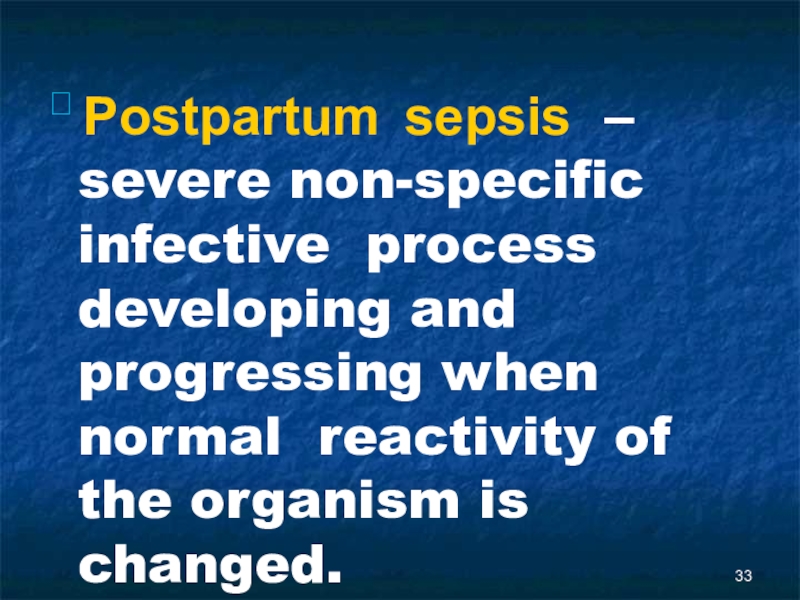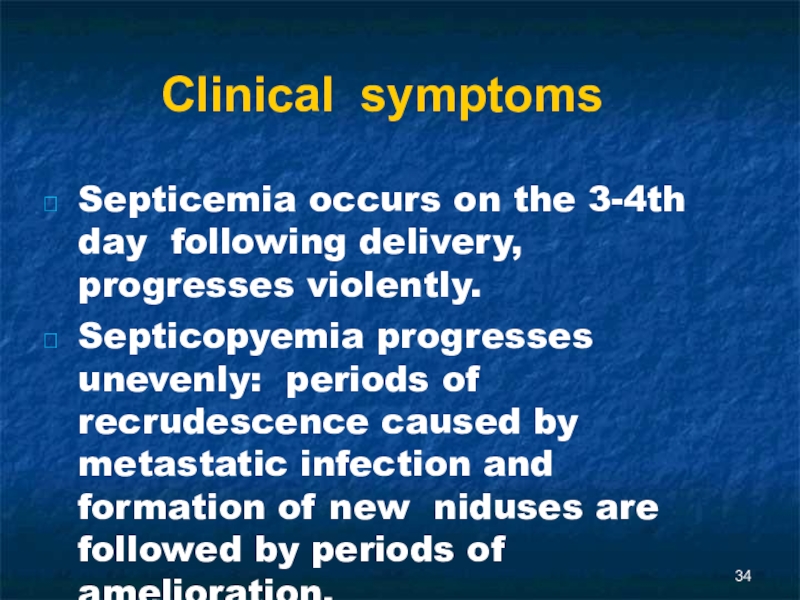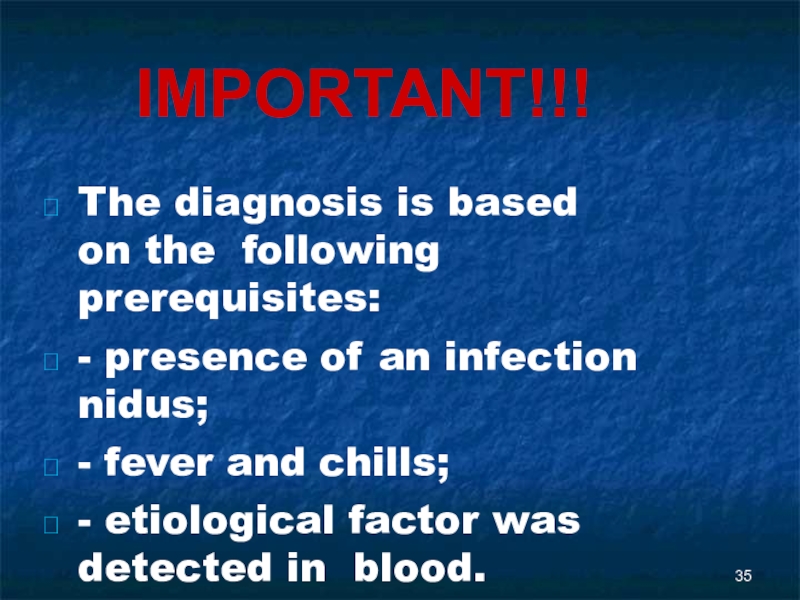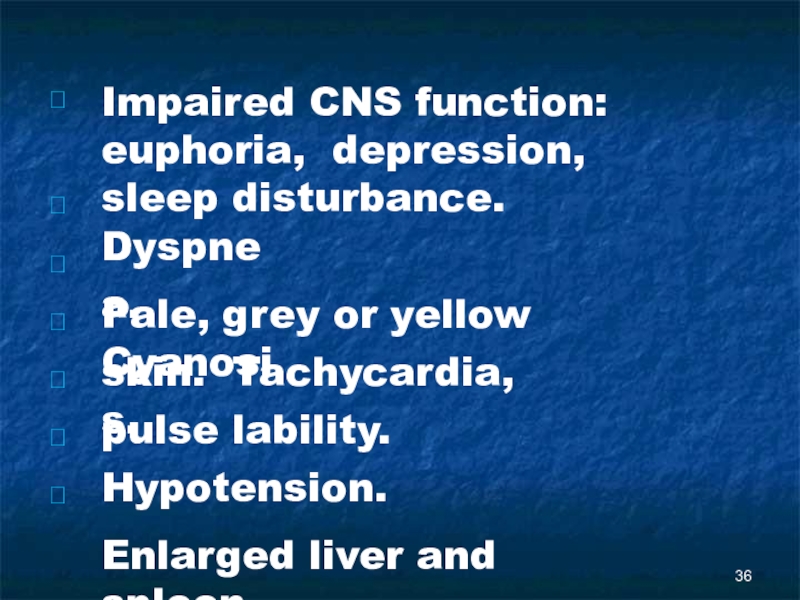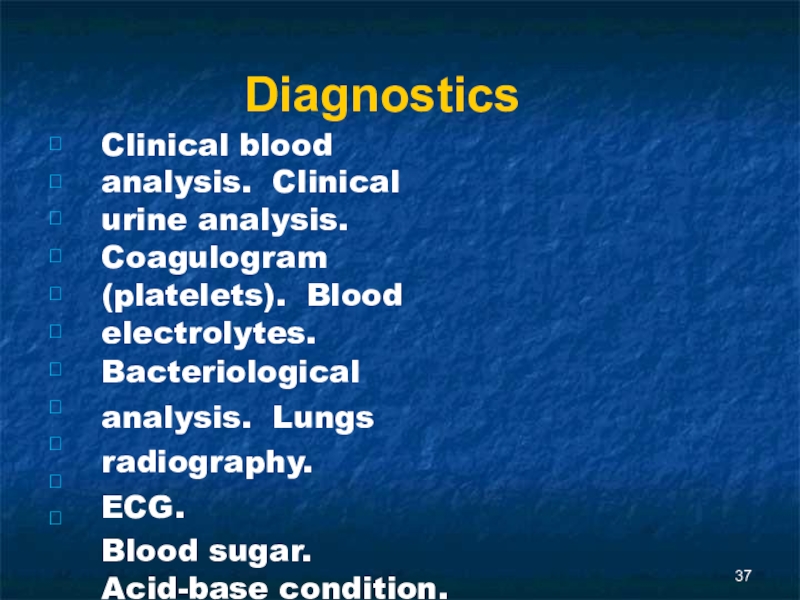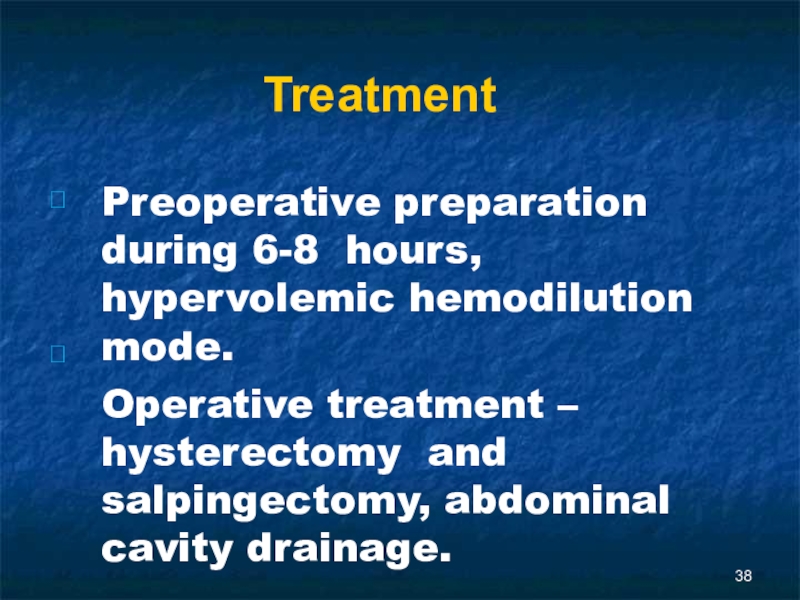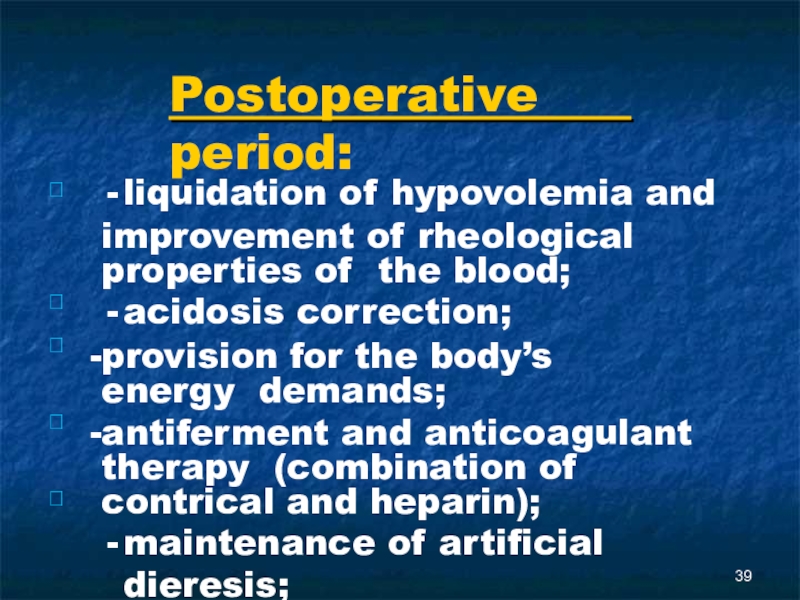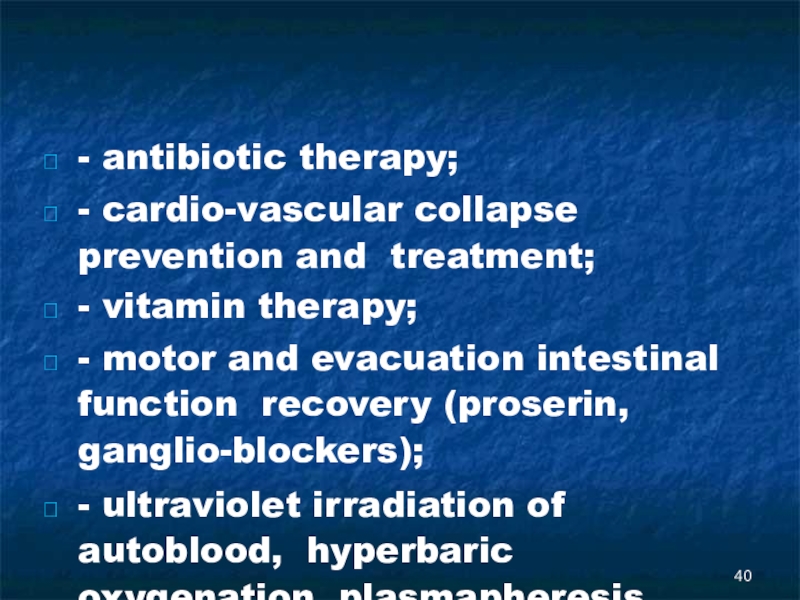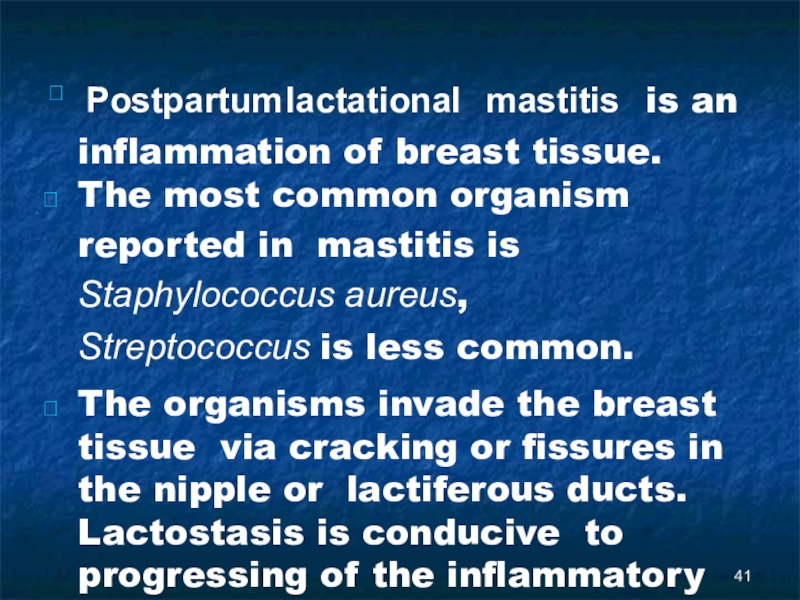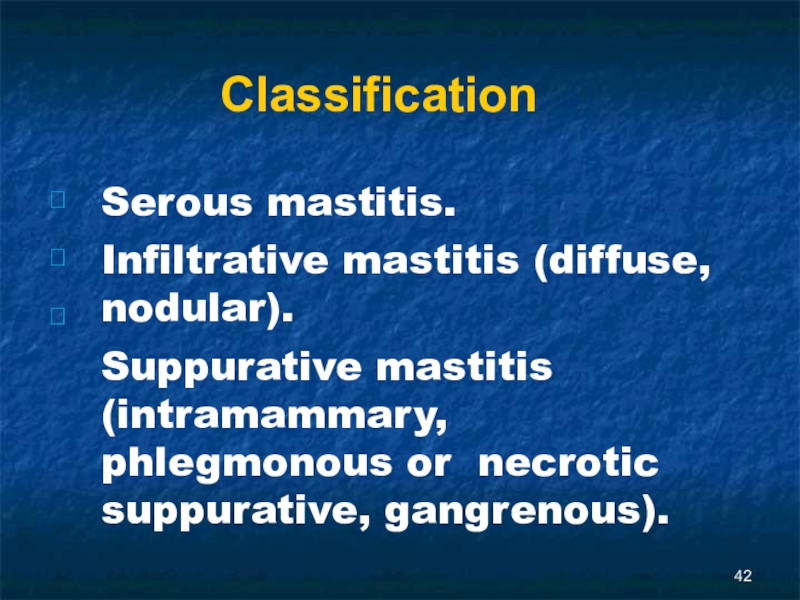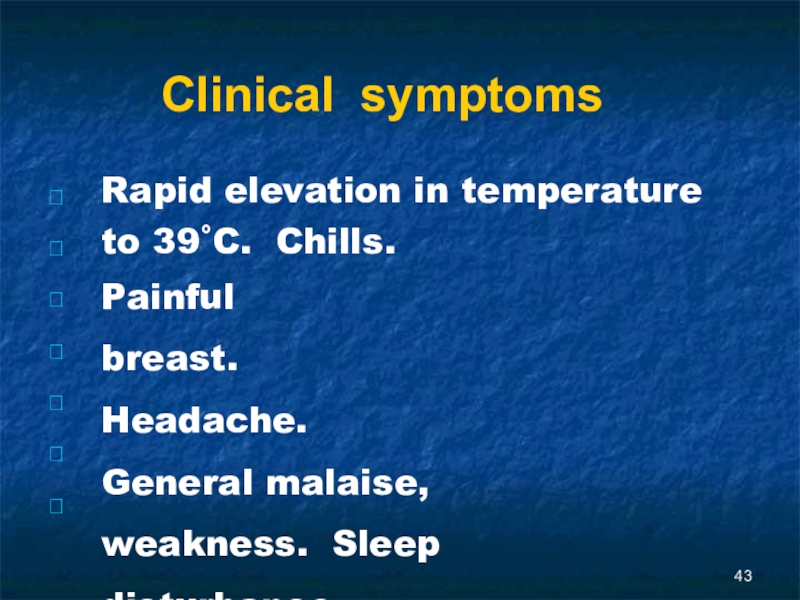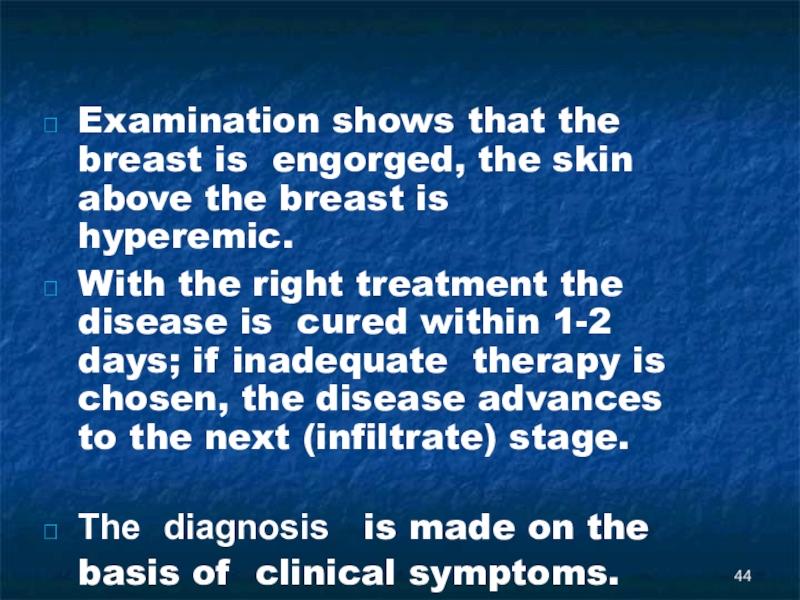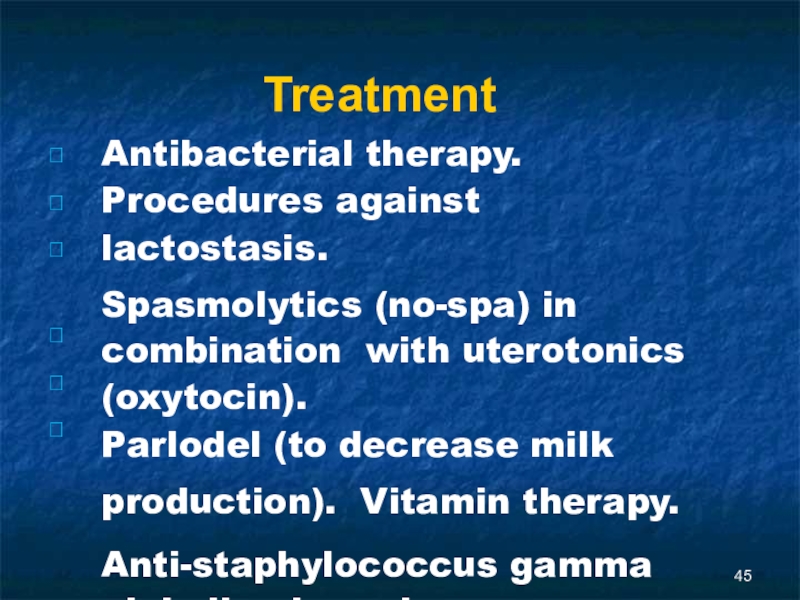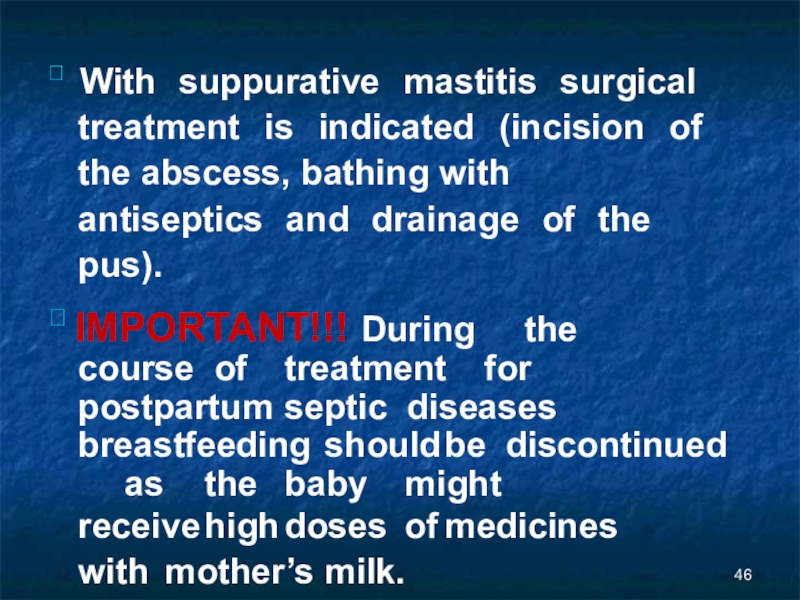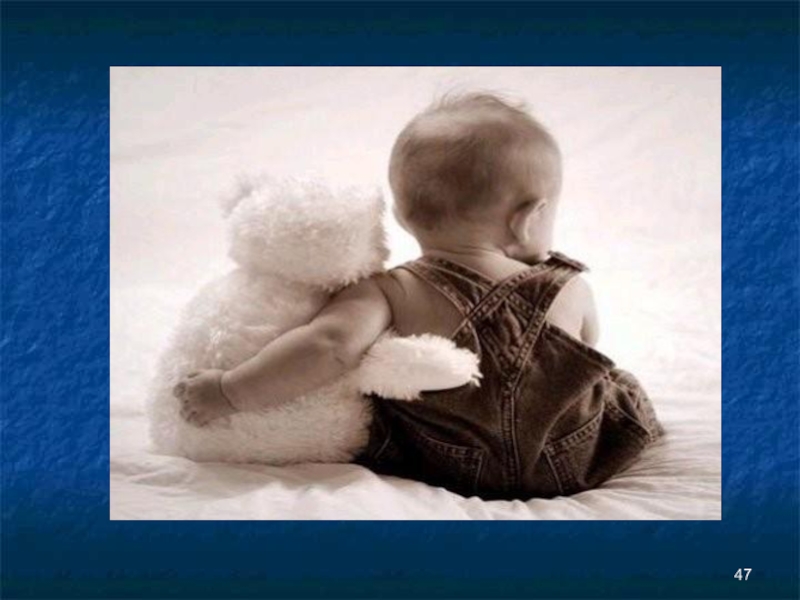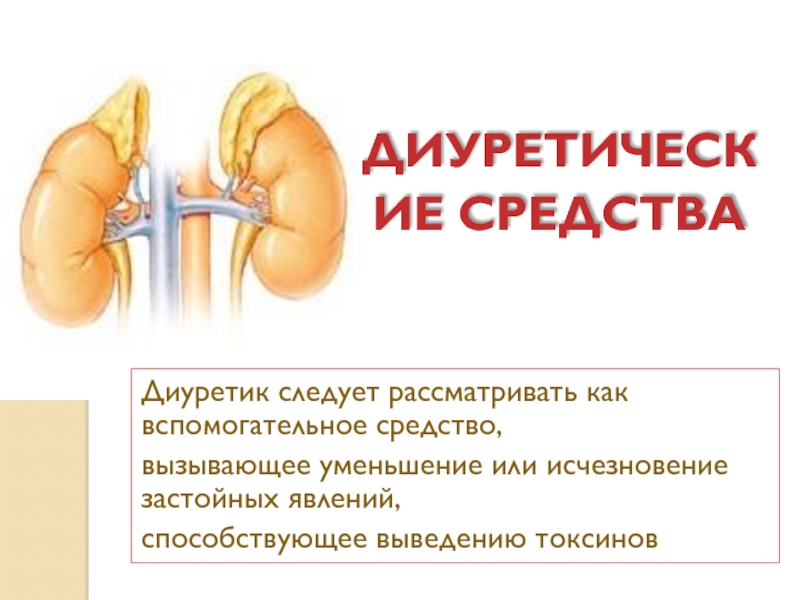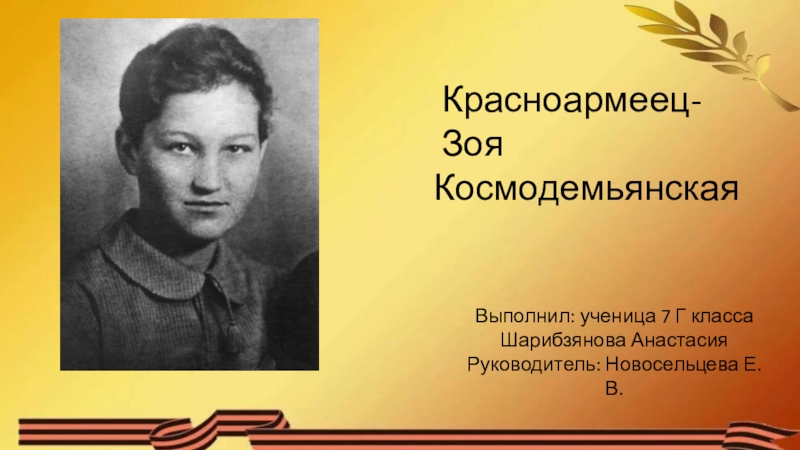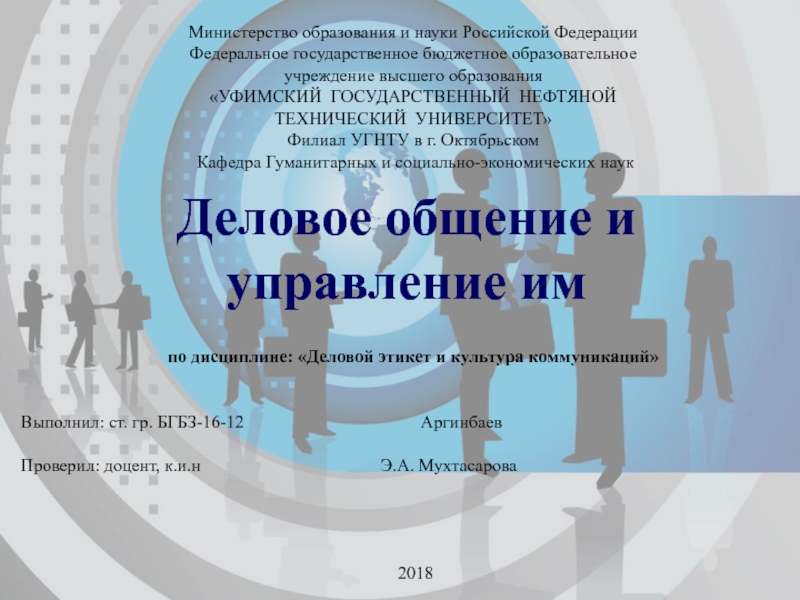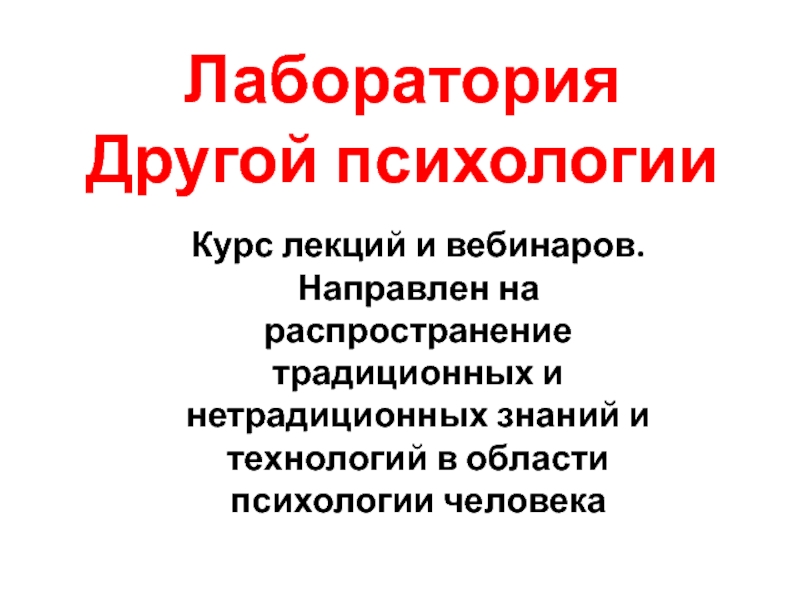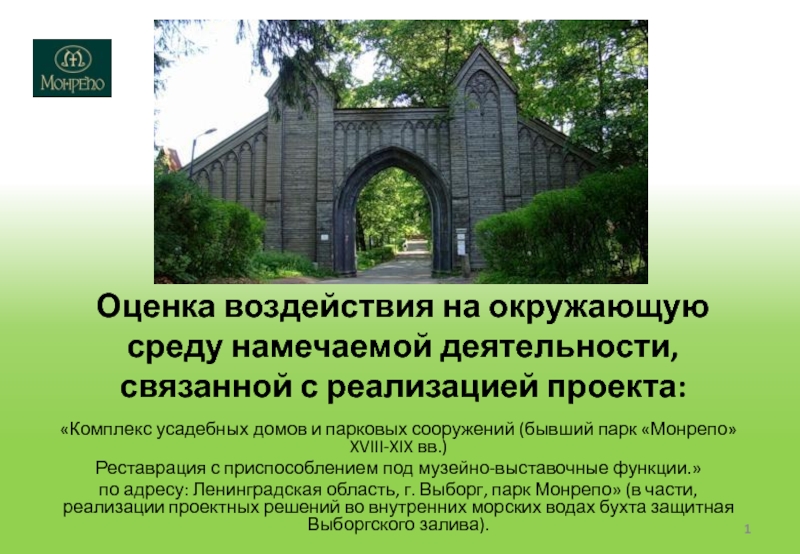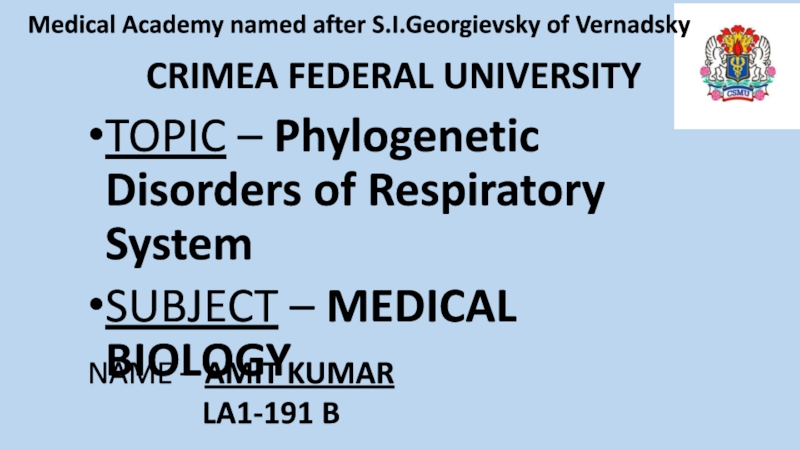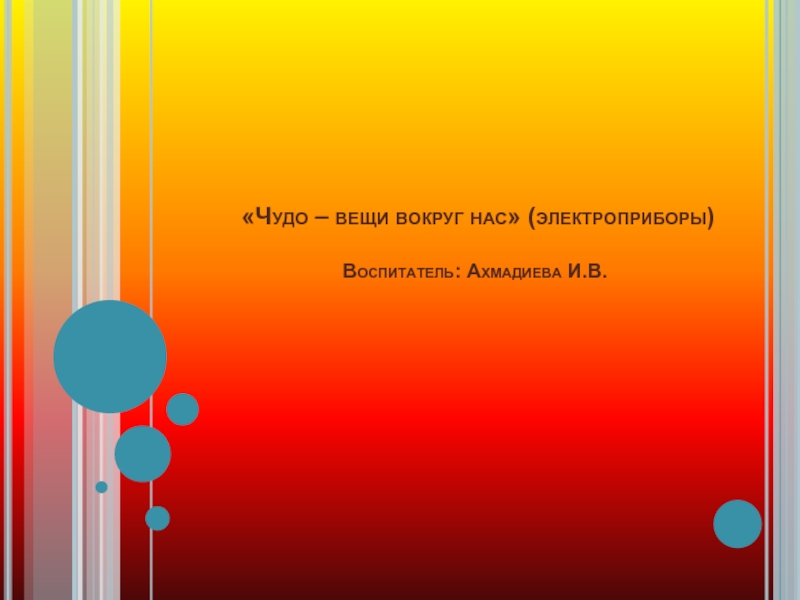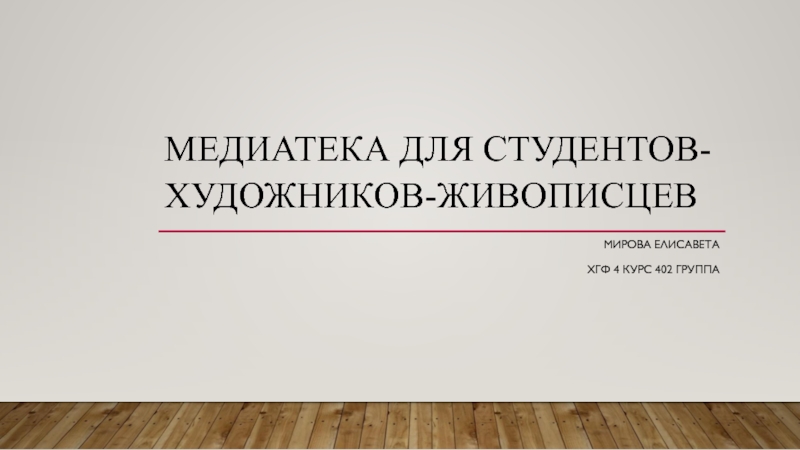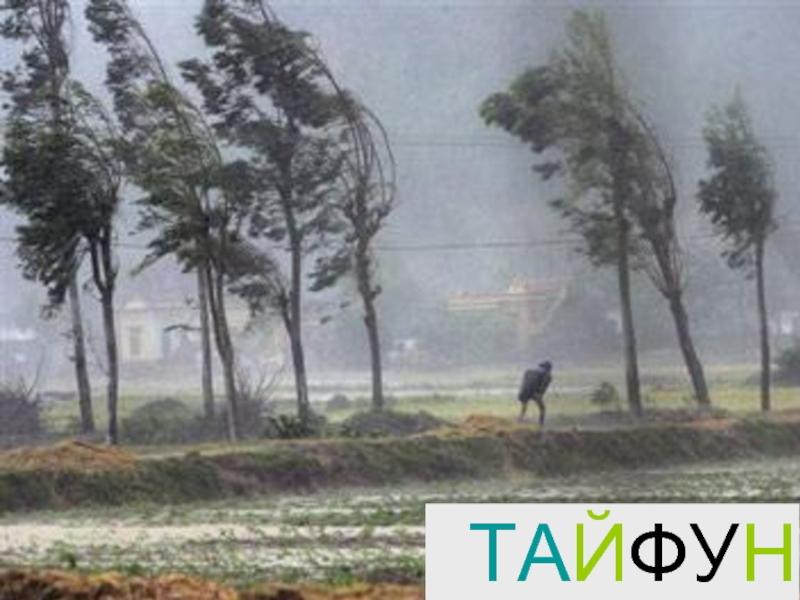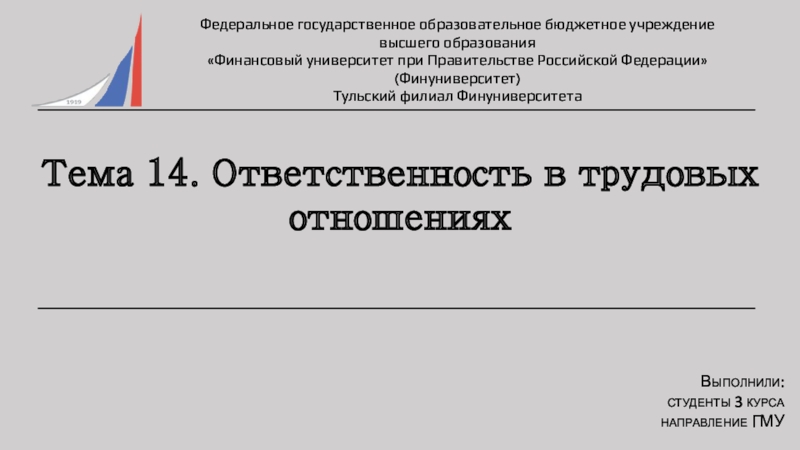Разделы презентаций
- Разное
- Английский язык
- Астрономия
- Алгебра
- Биология
- География
- Геометрия
- Детские презентации
- Информатика
- История
- Литература
- Математика
- Медицина
- Менеджмент
- Музыка
- МХК
- Немецкий язык
- ОБЖ
- Обществознание
- Окружающий мир
- Педагогика
- Русский язык
- Технология
- Физика
- Философия
- Химия
- Шаблоны, картинки для презентаций
- Экология
- Экономика
- Юриспруденция
Postpartum infection
Содержание
- 1. Postpartum infection
- 2. Postpartum infection – is a septic wound infection distinguished by
- 3. Classification principles- By prevalence: local, generalized forms.- By infection localization: vagina, uterus, ovaries, parametric tissue,
- 4. Factors making patients susceptible to infectionChanges in vaginal biocenose in final stages of pregnancy.Pregnancy-related immunodeficiency development. Delivery type.
- 5. SponsoredMedical Lecture Notes – All SubjectsUSMLE Exam (America) – Practice
- 6. Important!!! In the postpartum period the intra-
- 7. EtiologyIron-deficiency anemia. Gestosis.Placental presentation. Pyelonephritis.Prolonged labour. Prolonged
- 8. Postpartum ulcer – is caused by contamination of abrasions, fissures,
- 9. DiagnosticsHyperemia. Edema.Necrotic or purulent wound incrustation.
- 10. TreatmentThe wounds are cleansed with antiseptics locally
- 11. Postpartumendomyometritis.The most common infection in the postpartum period!
- 12. CLINICAL SYMPTOMS.ACUTE FORM.Temperature elevation › 38° on 2-5th
- 13. DIAGNOSTICSBimanual examination (the uterus is enlarged, painful,
- 14. TREATMENTBed rest.Antibiotic therapy (semisynthetic penicillin, combination of
- 15. Important!!!If the examination reveals placental tissues or
- 16. Postpartum salpingo-oophoritis is rarely observed. The ovaries
- 17. Postnatal parametritis – the process normally begins when
- 18. Clinical symptomsChills on the 10-12th day following delivery.Temperature
- 19. On bimanual examination a painful infiltrate
- 20. Postnatal trombophlebitis (affecting pelvis minor veins, superficial and deep veins of lower limbs).CausesHypercoagulation.Vessel wall lesions.
- 21. Clinical symptomsTemperature elevation.Hyperemia and tenderness along of varix
- 22. 22TreatmentBed rest, lower limb should be maintained
- 23. Obstetric peritonitis.Causes.Consequence of endomyometritis.Perforation of inflammatory tubo-ovarian mass.Torsion
- 24. PathogenesisEndogenous intoxicationGeneralized vascular disorders General tissue hypoxiaMetabolic
- 25. Enteroparesis. Motor, secretion, and absorption functions
- 26. Obstetric peritonitisphasesReactive phase (compensatory mechanisms preserved).Toxic phase. Terminal phase.
- 27. Clinical symptomspsychomotor agitationthirstdryness of mucous membranesgeneral weaknesstachycardia (does
- 28. unsatisfactory sleepabsence of appetitepallor of the skinnauseaeructationflatulencevomiting
- 29. On palpation: the abdomen is distended,
- 30. Treatment.Preoperative preparation (2 hours): stomachdecompression, infusion therapy
- 31. Postoperative period:liquidation of hypovolemia andimprovement of rheological
- 32. - antibiotic therapy;- cardio-vascular collapse prevention and
- 33. Postpartum sepsis – severe non-specific infective process developing
- 34. Clinical symptomsSepticemia occurs on the 3-4th day following
- 35. IMPORTANT!!!The diagnosis is based on the following
- 36. Impaired CNS function: euphoria, depression, sleep disturbance.Dyspnea.
- 37. DiagnosticsClinical blood analysis. Clinical urine analysis. Coagulogram
- 38. TreatmentPreoperative preparation during 6-8 hours, hypervolemic hemodilution mode.Operative treatment – hysterectomy and salpingectomy, abdominal cavity drainage.
- 39. Postoperative period:liquidation of hypovolemia andimprovement of rheological
- 40. - antibiotic therapy;- cardio-vascular collapse prevention and
- 41. Postpartum lactational mastitis is an inflammation of breast tissue.The most
- 42. ClassificationSerous mastitis.Infiltrative mastitis (diffuse, nodular).Suppurative mastitis (intramammary, phlegmonous or necrotic suppurative, gangrenous).
- 43. Clinical symptomsRapid elevation in temperature to 39˚C. Chills.Painful breast. Headache.General malaise, weakness. Sleep disturbance.Loss of appetite.
- 44. Examination shows that the breast is engorged,
- 45. TreatmentAntibacterial therapy. Procedures against lactostasis.Spasmolytics (no-spa) in
- 46. 46 With suppurative mastitis surgical treatment is
- 47. 47
- 48. Скачать презентанцию
Postpartum infection – is a septic wound infection distinguished by anatomic features of female reproductive organs and their functional status during pregnancy.
Слайды и текст этой презентации
Слайд 1Postpartum infection
Teacher: Kamilova Irina Kaharovna
Student: Sulur PerumalSwamy Venkatesh Prabhu
Group: 163(B)-CO-LA1 Course:
5
Слайд 2Postpartum infection – is a septic wound infection distinguished by anatomic features of
female reproductive organs and their functional status during pregnancy.
Слайд 3Classification principles
- By prevalence: local, generalized forms.
- By infection localization: vagina, uterus, ovaries, parametric tissue, pelvis minor veins,
mammary gland.
- By infection type: aerobic (enterococci, Escherichia coli, Klebsiella, group B streptococci,
staphylococci); anaerobic (Bacteroids, fusobacteria, peptococci, peptostreptococcus); gram-positive, gram- negative, mycoplasma, Chlamydia, fungi.Слайд 4Factors making patients susceptible to infection
Changes in vaginal biocenose in final stages of pregnancy.
Pregnancy-related
immunodeficiency development. Delivery type.
Слайд 6Important!!!
In the postpartum period the intra- uterine wall is
a traumatic surface easily infected by the spread of pathogenic
and opportunistic pathogenic flora.Слайд 7Etiology
Iron-deficiency anemia. Gestosis.
Placental presentation. Pyelonephritis.
Prolonged labour. Prolonged anhydrous term. Serious
loss of blood.
Genital tract wounds. Surgical procedures.
Слайд 8Postpartum ulcer – is caused by contamination of abrasions, fissures, ruptures of vulval
and vaginal mucous membranes.
The patient’s general condition is satisfactory.
Слайд 10Treatment
The wounds are cleansed with antiseptics locally (hydrogen peroxide, furacilin,
chlorhexidine, dioxidine, hypertonic solution).
Wound debridement with proteolytic ferments is performed
(tripsin, chemotripsin).After the wound has been cleansed from pus, ointment bandages are applied (levomicole, dioxicole).
Слайд 12CLINICAL SYMPTOMS.
ACUTE FORM.
Temperature elevation › 38° on 2-5th day following delivery.
Chills.
Abdominal
pain.
Foul-smelling, pus-containing lochia.
Headache.
Facial hyperemia.
Postpartum psychosis (the degree depends on the
level of intoxication).Слайд 13DIAGNOSTICS
Bimanual examination (the uterus is enlarged, painful, softened, contractive movements
are restricted).
Clinical blood count. Ultrasonography.
Thermometry.
Bacterioscopic and bacteriological analysis of vaginal
discharge.Biochemical blood test (c-reactive protein increase, hypoproteinemia, hypoalbuminemia).
Coagulogram. Hysteroscopy.
Clinical urine analysis.
Слайд 14TREATMENT
Bed rest.
Antibiotic therapy (semisynthetic penicillin, combination of cephalosporin and metronidazole).
Infusion
therapy (combination of colloids and crystalloids).
10% calcium gluconate, 10 ml i.v.
Vitamin therapy.Spasmolytics (no-spa, papaverine hydrochloride).
Immunomodulators.
Intrauterine lavage with antiseptic
Слайд 15Important!!!
If the examination reveals placental tissues or membranes in the
uterine cavity, it is necessary to perform curettage or vacuum
aspiration of the uterus.LOW-GRADE ENDOMYOMETRITIS progresses without pronounced clinical symptoms. The onset of the disease is normally on the 7-9th day following delivery. The most common causes of the disease are Chlamydia or mycoplasma infections.
Слайд 16 Postpartum salpingo-
oophoritis is rarely observed. The ovaries are normally affected
on one side. The clinical history of the disease is
similar to manifestations of endomyometritis, which is followed by salpingo-oophoritisСлайд 17 Postnatal parametritis – the process normally begins when lacerations or infections
of the cervix are present.
Lateral parts of parametrium are commonly
affected.Слайд 18Clinical symptoms
Chills on the 10-12th day following delivery.
Temperature elevation to 39
- 40°. Tensive lower abdominal pain.
Acruturesis or dyschezia in cases
when the process has spread to front or back parametrium.Слайд 19 On bimanual examination a painful infiltrate is found in
the fornices, the fornices are shortened.
For diagnostics and treatment
see endomyometritis.Слайд 20Postnatal trombophlebitis (affecting pelvis minor veins, superficial and deep veins of
lower limbs).
Causes
Hypercoagulation.
Vessel wall lesions.
Слайд 21Clinical symptoms
Temperature elevation.
Hyperemia and tenderness along of varix dilatated shin veins.
Edema
(if deep veins of lower limbs are involved).
Слайд 2222
Treatment
Bed rest, lower limb should be maintained uplifted.
Antibacterial therapy.
Anticoagulants: direct
effect (heparin), indirect effect (kleksan, fraxiparin, troxevasin, aspirin).
Medicines improving rheological
properties of the blood: rheopolyglukin, trental, kurantil.Hirudotherapy.
Слайд 23Obstetric peritonitis.
Causes.
Consequence of endomyometritis.
Perforation of inflammatory tubo-ovarian mass.
Torsion of ovarian tumor
pedicle.
Necrosis of the subserous node of hysteromyoma.
Infected rupture of uterine
sutures after caesarean section.Слайд 24Pathogenesis
Endogenous intoxication
Generalized vascular disorders General tissue hypoxia
Metabolic disorders
Dysfunction of essential
organs and systems Destructive changes in kidneys, pancreas, liver, small
intestineEnteroparesis
Слайд 25 Enteroparesis. Motor, secretion, and absorption functions are affected.
Significant amounts
of protein and electrolyte containing liquid accumulate in the intestinal
lumen. Overdistension and ischemia of the intestinal wall cause impairment of the intestinal barrier function which leads to increased intoxicationСлайд 26Obstetric peritonitis
phases
Reactive phase (compensatory mechanisms preserved).
Toxic phase. Terminal phase.
Слайд 27Clinical symptoms
psychomotor agitation
thirst
dryness of mucous membranes
general weakness
tachycardia (does not correspond to
the body temperature)
fever
pulse rate exceeds 100bpm
shallow breathing
Слайд 28unsatisfactory sleep
absence of appetite
pallor of the skin
nausea
eructation
flatulence
vomiting (not always)
the pain
syndrome is not evident (due to
overdistension of the front abdominal
wall after delivery).Слайд 29 On palpation: the abdomen is distended, the uterus is
enlarged, softened, the contours are indistinct, peritoneum irritation symptoms are
not pronounced, sluggish peristalsis, slow flatus discharge.Слайд 30Treatment.
Preoperative preparation (2 hours): stomach
decompression, infusion therapy intended for liquidation
of hypovolemia and metabolic acidosis, fluid, protein and electrolytic balance
correction, detoxication of the body, antibacterial therapy.Operative treatment: hysterectomy, abdominal cavity drainage.
Слайд 31Postoperative period:
liquidation of hypovolemia and
improvement of rheological properties of the
blood;
acidosis correction;
provision for the body’s energy demands;
antiferment and anticoagulant therapy
(combination of contrical and heparin);maintenance of artificial dieresis;
Слайд 32- antibiotic therapy;
- cardio-vascular collapse prevention and treatment;
- vitamin therapy;
-
motor and evacuation intestinal function recovery (proserin, ganglio-blockers);
- ultraviolet irradiation
of autoblood, hyperbaric oxygenation.Слайд 33 Postpartum sepsis – severe non-specific infective process developing and progressing when
normal reactivity of the organism is changed.
Слайд 34Clinical symptoms
Septicemia occurs on the 3-4th day following delivery, progresses violently.
Septicopyemia
progresses unevenly: periods of recrudescence caused by metastatic infection and
formation of new niduses are followed by periods of amelioration.Слайд 35IMPORTANT!!!
The diagnosis is based on the following prerequisites:
- presence of
an infection nidus;
- fever and chills;
- etiological factor was detected
in blood.Слайд 36
Impaired CNS function: euphoria, depression, sleep disturbance.
Dyspnea. Cyanosis.
Pale, grey or
yellow skin. Tachycardia, pulse lability. Hypotension.
Enlarged liver and spleen.
Слайд 37Diagnostics
Clinical blood analysis. Clinical urine analysis. Coagulogram (platelets). Blood electrolytes.
Bacteriological
analysis. Lungs radiography.
ECG.
Blood sugar.
Acid-base condition. Central venous pressure.
Monitoring: arterial pressure,
pulse rate, heart rate, body temperature.Слайд 38Treatment
Preoperative preparation during 6-8 hours, hypervolemic hemodilution mode.
Operative treatment –
hysterectomy and salpingectomy, abdominal cavity drainage.
Слайд 39Postoperative period:
liquidation of hypovolemia and
improvement of rheological properties of the
blood;
acidosis correction;
provision for the body’s energy demands;
antiferment and anticoagulant therapy
(combination of contrical and heparin);maintenance of artificial dieresis;
Слайд 40- antibiotic therapy;
- cardio-vascular collapse prevention and treatment;
- vitamin therapy;
-
motor and evacuation intestinal function recovery (proserin, ganglio-blockers);
- ultraviolet irradiation
of autoblood, hyperbaric oxygenation, plasmapheresis, hemosorption, hemodialysis.Слайд 41 Postpartum lactational mastitis is an inflammation of breast tissue.
The most common organism reported
in mastitis is Staphylococcus aureus, Streptococcus is less common.
The organisms
invade the breast tissue via cracking or fissures in the nipple or lactiferous ducts. Lactostasis is conducive to progressing of the inflammatory process.Слайд 42Classification
Serous mastitis.
Infiltrative mastitis (diffuse, nodular).
Suppurative mastitis (intramammary, phlegmonous or necrotic
suppurative, gangrenous).
Слайд 43Clinical symptoms
Rapid elevation in temperature to 39˚C. Chills.
Painful breast. Headache.
General malaise,
weakness. Sleep disturbance.
Loss of appetite.
Слайд 44Examination shows that the breast is engorged, the skin above
the breast is hyperemic.
With the right treatment the disease is
cured within 1-2 days; if inadequate therapy is chosen, the disease advances to the next (infiltrate) stage.The diagnosis is made on the basis of clinical symptoms.
Слайд 45Treatment
Antibacterial therapy. Procedures against lactostasis.
Spasmolytics (no-spa) in combination with uterotonics
(oxytocin).
Parlodel (to decrease milk production). Vitamin therapy.
Anti-staphylococcus gamma globulin, hyperimmune
anti-staphylococcus plasma.Слайд 4646
With suppurative mastitis surgical treatment is indicated (incision of
the abscess, bathing with
antiseptics and drainage of the pus).
IMPORTANT!!!
During the course of treatment for postpartum septic diseases breastfeeding should be discontinued as the baby mightreceive high doses of medicines with mother’s milk.
